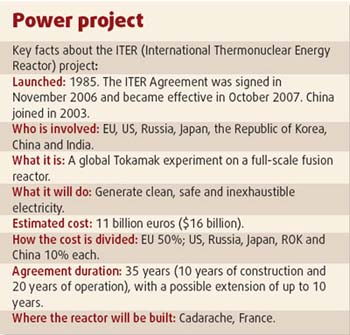China will contribute about 10 billion yuan ($1.4 billion) to the International Thermonuclear Experimental Reactor (ITER) project, construction of which will begin in France this year.
The figure represents about 10 percent of the project's cost.
About half of China's contribution will be spent during the 10-year construction phase of the multination undertaking, sources at the Oriental Science and Technology Forum, held in Shanghai last weekend, said.
"The goal of the project is to find a shortcut to solve our energy shortage," Luo Delong, deputy director of the ITER China Office, told the forum.
He said Chinese researchers would be in charge of building components such as heating, diagnostic and remote maintenance equipment, as well as transporting it to Cadarache in the south of France, where the ITER reactor would be built.
ITER, which means "the way" in Latin, is an 11-billion-euro ($15.5 billion) experiment to study the scientific and technical feasibility of the world's most advanced nuclear fusion reactor. The device is described as an "artificial sun" as it will create conditions similar to those occurring in solar nuclear fusion reactions.
If successful, the project could generate infinite, safe and clean energy to replace fossil fuels such as oil and coal, and will be 30 times more powerful than the Joint European Torus (JET), the largest comparable experiment.
The ITER project was first initiated by the United States and the then Soviet Union in the mid-1980s. Today, it involves the European Union (EU), the US, Japan, Russia, the Republic of Korea, China and India. China joined in February 2003.
The ITER Agreement, signed in November 2006, came into effect last October and has an initial duration of 35 years, though it could be extended for an additional 10 years.
Under the agreement, the EU will be responsible for half of the construction costs, while the other five parties excluding India, will contribute equally to cover the remaining expenses.
Earlier reports said China would send 30 scientists to France during the construction phase. At the moment, more than a dozen scientists and managers are already working at Cadarache, and more will soon join them.
Russia, France and Japan have all developed similar experimental fusion reactors.
China became the first country to build a superconducting experimental Tokamak fusion device in September, after successfully completing a series of trials in Hefei, capital of Anhui Province. Despite this success, China still faces a shortage of talent in the field. Scientists and researchers have called for increased efforts to train more scientists to improve the nation's research capabilities.
(China Daily January 8, 2008)


